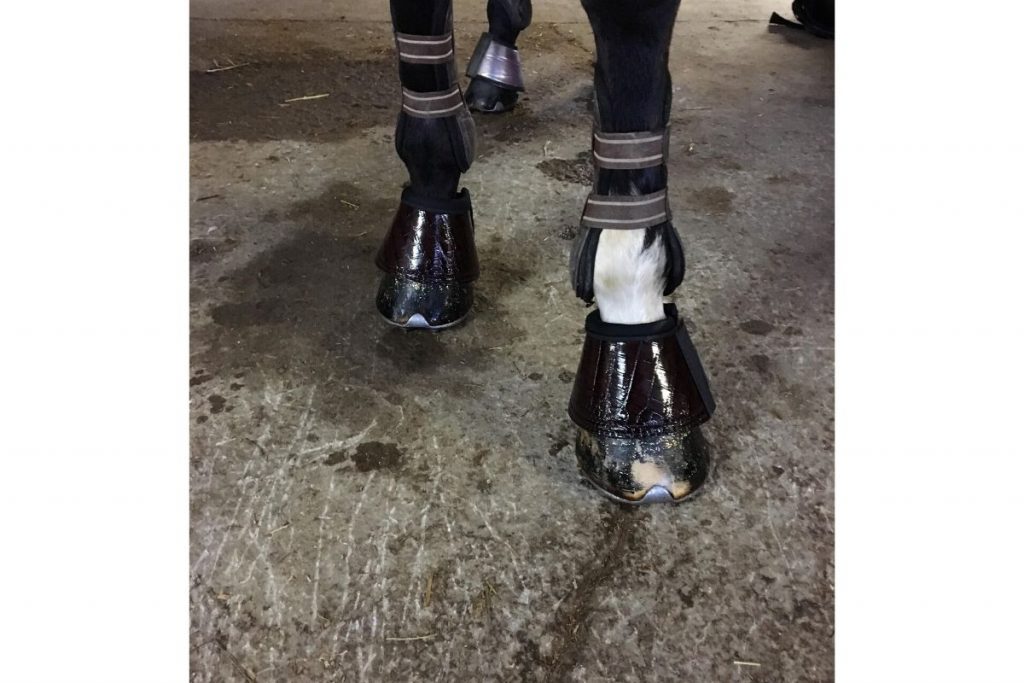If you want to put horseshoes on a horse or take them off, you may need to be careful. After all, a horse is a living animal, so you need to account for their hooves and any feeling that might be there. That way, you can give your horse horseshoes without causing unnecessary harm to the animal.
Do horses have feeling in their hooves? Horses do not have nerve endings in the outer part of their hooves, so their hooves can get damaged without their knowledge. Because of this, horses need horseshoes to protect their hooves. However, since they don’t have much feeling in their hooves, a farmer can easily put shoes on a horse’s hooves.
While horses don’t have nerve endings in their hooves, they can still have some feeling there. If they haven’t worn horseshoes or if an ill-fitting shoe is used, the horse can feel that, and it can cause pain. Luckily, following the right procedure for fitting horseshoes can protect a horse’s hooves.

Is it Painful for Horses to Get Shoes?
Proponents of letting horses go barefoot might argue that putting on horseshoes can be bad for your horse. When not done correctly, shoes can cause more pain for your horse than going barefoot. However, if horseshoes are applied by someone who knows what they’re doing, shoes shouldn’t be a problem.
If you or a farrier (someone who puts on horseshoes) follows the right steps, your horse’s hooves can benefit from shoes. Of course, they will still have some feeling in their hooves. However, adding shoes can protect their feet on rougher terrain or after much activity.
When putting on a horseshoe, you need the shoe as well as nails and a tool to install the shoe. While there’s always a risk of hurting the horse when putting a shoe on, it’s not something to worry about. The outer layers of the hooves don’t have enough feeling to be hurt by the nails.
Still, things can go wrong when putting on shoes if you do it without any experience. If you decide to get horseshoes for your horse, make sure you enlist the help of a professional. They will have the tools and expertise necessary to apply horseshoes without hurting your horse or their hooves.
Why Do Horses Have Hooves?
All land animals need something to support their legs so that they can walk properly and not have issues. That’s especially important for horses since they spend much time standing and walking. To maintain the right gait and stance, horses have evolved to have a hoof at the bottom of each leg.
The ancestors of modern horses had three or four toes that they walked on. Over time, the smaller toes changed into one large toe, and there are a few theories about why. First, research has shown that a single large toe can manage the stress put on the bones better than multiple small toes.
Also, as horses grew larger, the weight and stress on their bones increased, which meant that more support was vital. While the weight of horses increased, so did the size of hooves since they can protect bones from stress. Hooves help manage shock when a horse runs or trots, so the bigger the hoof, the better the shock absorption.
This evolutionary trait has helped horses avoid or reduce the risk of injuries from running. Since they act as toes, though, they still need protection. Those hoofs aren’t made of hard bone, as you may think, so you can’t think of them like you would human feet, for example.
What Are Hooves Made Of?
While it can be easy to assume hooves are made of bone or another hard material, that’s not the case. Hooves are made of keratin, which is the same protein-like material that makes up your hair and fingernails. This means that the hooves are somewhat malleable, and they’re always growing.
- Horse hooves continue to grow, and they can grow the length of a new hoof in one year on average. This growth is essential for horses who don’t wear horseshoes since new cells can take over as older layers are worn down.
- Horses usually have multiple thick layers of keratin that make up their hooves. That way, the hoof should be enough to protect the horse and provide shock absorption.
- Since hooves don’t stop growing, it’s important to manage them so that they don’t get too long. While horseshoes are helpful, a horse that’s not too active can get away without wearing them.
Many horses can go their whole lives walking on their hooves without any extra protection. As the horse walks around, the outer layers of their hooves will wear down and make room for new layers. Just like hair or fingernails on humans, the outer layers of a hoof don’t have much feeling, though that doesn’t mean horses can’t benefit from horseshoes.

Are Horseshoes Necessary?
If you have an active horse, you should consider having your horse shod. The more your horse walks and runs–the more their hooves will wear down. This could be painful for the horse if they happen to wear through all the outer layers of their hooves.
Horseshoes solve the problem by giving your horse’s hooves some added protection. Instead of walking directly on the hooves, your horse will walk on the shoes. That can keep the hoof from wearing down too quickly, so shoes are an excellent option for competing horses and other active ones.
However, they aren’t necessary for all horses. If your horse isn’t that active, they may not wear down their hooves as quickly. That means that putting on horseshoes could do more harm than good to the hoof, especially if shoes aren’t put on correctly.
Some people also think that letting a horse go barefoot is easier and better for their hooves. If you choose to have your horse go barefoot, you still need to do some trimming to keep the hooves from getting out of control. Both options have pros and cons, so you need to decide what is best for your horse based on their environment and activity level.
How to Protect a Horse’s Hooves
If you decide to put horseshoes on your horse’s hooves, you need to take the right precautions. All the benefits of horseshoes won’t matter if you don’t put on the shoes correctly. While horses may not have much feeling in the outer layers of their hooves, they can feel the inner layers, and they can also feel the size.
- Before you put the shoes on, make sure they’re the right size. You can compare the size of the shoe to the size of your horse’s hoof.
- If you don’t know what size to get, consult a professional who can measure the hoof and suggest the right size for your horse.
- When it’s time to put the horseshoe on, clean off the hoof so that dust and dirt won’t get trapped. This is especially important if your horse has never had shoes.
- Be careful when nailing the shoe into the hoof. If you nail too deep, that can reach the inner layers of the hoof where the horse can still feel and experience pain.
Repeat the steps with each hoof so that your horse has a comfortable set of horseshoes. Of course, they can still feel the ground when wearing shoes, but you won’t have to worry about their hooves wearing down. If you decide not to put on horseshoes, make sure your horse has soft ground to walk on. This will keep them from wearing down the hooves too quickly.
Final Thoughts
It may seem obvious that horses have feeling in their hooves, but there’s more to the story. Whether you put horseshoes on their hooves or not, their hooves need adequate protection so that they don’t wear down faster than they can grow. If that happens, your horse could end up in much pain.
